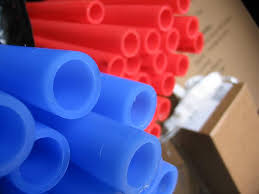
1. Flexibility. PEX has become a contender for use in residential water plumbing because of its flexibility. It can bend into a wide-radius turn if space permits, or accommodate turns by using elbow joints. In addition, it can handle short-radius turns, sometimes supported with a metal brace; in contrast, PVC, CPVC and copper all require elbow joints. A single length of PEX pipe cannot handle a sharp 90-degree turn, however, so in those situations, it is necessary to connect two PEX pipes with a 90-degree PEX elbow joint.
2. Direct routing of pipes. PEX can run straight from a distribution point to an outlet fixture without cutting or splicing the pipe. This reduces the need for potentially weak and costly joints and reduces the drop in pressure due to turbulence induced at transitions. Since PEX is flexible, it is often possible to install a supply line directly from the water source to an appliance using just one connection at each end.
3. Greater water pressure. Since PEX pipes typically have fewer sharp turns, there can be greater water pressure at the sinks and showers and toilets where it is needed.
4. Less materials cost. Cost of materials is approximately 25% to 35% of alternatives.
5. Easier installation. Installing PEX is much less labor intensive than copper pipes, since there is no need to use torches to solder pipes together, or to use glue to attach pipes to fittings. Builders putting in radiant heating systems found that PEX pipes “made installation easy and operation problem-free.” PEX connections can be made by pushing together two matching parts using a compression fitting, or by using an adjustable wrench or a special crimping tool. Generally, fewer connections and fittings are needed in a PEX installation.
6. Reliable. It neither corrodes nor develops so-called “pinhole” leaks.
7. No fire risk during installation. Copper piping required soldering using torches, and there was a risk of flame and heat causing a fire; but with PEX there is virtually no danger from fire. Overall PEX piping is much safer to install..
8. Ability to merge new PEX with existing copper and PVC systems. Manufacturers make fittings allowing installers to join a copper pipe on one end with a PEX line at the other, as well as have options to reduce or expand the diameter of the pipes.
9. Longevity. The advantageous properties of PEX also make it a candidate for progressive replacement of metal and thermoplastic pipes, especially in long-life applications, because the expected lifetime of PEX pipes reaches 50 years. However, the longest warranty offered by any PEX producer is 25 years.
10. Freeze damage. The general position is that PEX plastic materials are slower to burst than copper or PVC pipes, but that they will burst eventually since freezing causes water to expand. PEX water-filled pipes, frozen over time, will swell and tear; in contrast, copper pipe “rips” and PVC “shatters”. on the first freeze. In new unheated seasonal homes, it is still recommended to drain pipes during an unheated cold season or take other measures to prevent pipes from bursting because of the cold. Read more on Frozen Pipes: Preventing and Thawing.
11. No corrosion. Copper and iron pipes can experience corrosion leaks but PEX does not have these problems.
12. Manufacturer. Beware of pex tubing not made by either Upinor, (also known as Wirsbo), or Rehau. Other types of pex and fittings are a roll of the dice. You may save money with the initial expense. You may pay 20 times more to replace it later.
